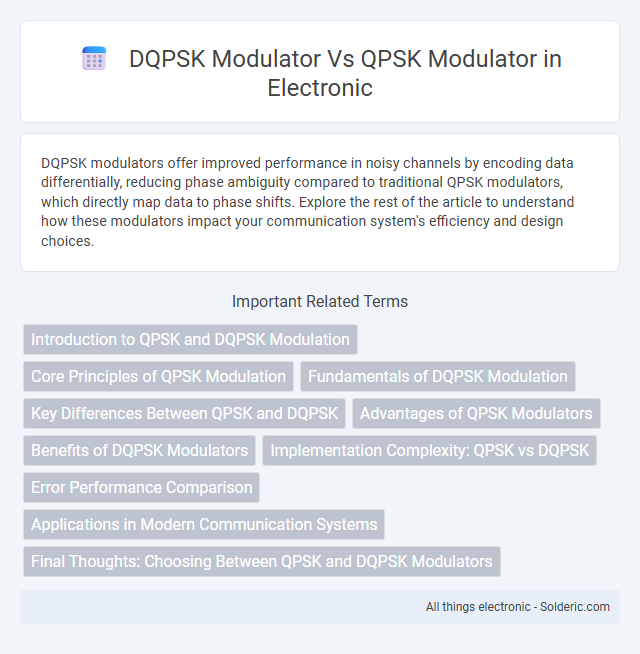DQPSK modulators offer improved performance in noisy channels by encoding data differentially, reducing phase ambiguity compared to traditional QPSK modulators, which directly map data to phase shifts. Explore the rest of the article to understand how these modulators impact your communication system's efficiency and design choices.
Comparison Table
| Feature | DQPSK Modulator | QPSK Modulator |
|---|---|---|
| Modulation Type | Differential Quadrature Phase Shift Keying | Quadrature Phase Shift Keying |
| Phase Encoding | Phase difference between consecutive symbols | Absolute phase of each symbol |
| Complexity | Lower transmitter complexity, no need for phase synchronization | Higher transmitter and receiver complexity, requires phase synchronization |
| Performance in Noisy Channels | More robust to phase noise and phase ambiguity | Sensitive to phase noise and requires precise synchronization |
| Bit Error Rate (BER) | Slightly higher BER compared to QPSK under ideal conditions | Lower BER under ideal conditions |
| Application | Used where phase synchronization is difficult or costly | Preferred in systems with reliable phase reference and synchronization |
| Implementation | Uses differential encoding and decoding | Standard coherent detection |
Introduction to QPSK and DQPSK Modulation
QPSK (Quadrature Phase Shift Keying) modulates data by shifting the phase of a carrier signal in four discrete steps, allowing efficient transmission of two bits per symbol. DQPSK (Differential Quadrature Phase Shift Keying) improves error resilience by encoding data in phase changes between consecutive symbols, eliminating the need for coherent phase reference at the receiver. Your choice between QPSK and DQPSK modulation impacts system complexity and robustness, with DQPSK offering better performance in noisy environments.
Core Principles of QPSK Modulation
QPSK modulation encodes data by altering the phase of a carrier signal into four distinct states, each representing two bits, enhancing spectral efficiency. The core principle relies on shifting the carrier phase by 0deg, 90deg, 180deg, or 270deg, allowing robust data transmission with minimal bandwidth usage. While a DQPSK modulator uses differential encoding to convey phase changes rather than absolute phases, a QPSK modulator directly maps data bits to specific phase shifts, which can make your system more susceptible to phase ambiguity without differential detection.
Fundamentals of DQPSK Modulation
Differential Quadrature Phase Shift Keying (DQPSK) modulation encodes data by varying the phase difference between consecutive symbols, enhancing robustness against phase ambiguity and simplifying receiver design compared to traditional QPSK. Unlike QPSK, which directly assigns data bits to absolute phase states, DQPSK transmits information via phase transitions, making it more resilient to phase noise and synchronization errors. This modulation technique is highly effective in communication systems where maintaining phase coherence is challenging, ensuring reliable data transmission and reducing error rates in your signal processing applications.
Key Differences Between QPSK and DQPSK
DQPSK (Differential Quadrature Phase Shift Keying) modulator encodes data by detecting changes in phase rather than absolute phase as in QPSK (Quadrature Phase Shift Keying), which simplifies phase ambiguity issues and reduces the need for complex phase synchronization. QPSK transmits two bits per symbol using four distinct phase states, while DQPSK transmits data based on the phase difference between successive symbols, enhancing robustness to phase noise and channel impairments. Consequently, DQPSK modulator offers improved performance in environments with rapid phase variations, making it suitable for wireless communication systems requiring simpler receiver design and greater resilience.
Advantages of QPSK Modulators
QPSK modulators offer enhanced spectral efficiency by encoding two bits per symbol, which doubles the data rate compared to BPSK without increasing bandwidth. They provide robustness against noise and phase errors, ensuring reliable communication in wireless and satellite systems. The simpler demodulation process of QPSK modulators reduces receiver complexity while maintaining high data throughput, making them ideal for digital communication applications requiring efficient bandwidth utilization.
Benefits of DQPSK Modulators
DQPSK modulators offer improved spectral efficiency by encoding data in phase differences, reducing the effects of phase ambiguity and enhancing signal robustness in noisy channels compared to QPSK modulators. The differential encoding eliminates the need for complex phase synchronization, enabling simpler receiver design and lower latency in communication systems. This modulation technique also provides better performance in multipath fading environments, making it ideal for wireless and optical communication applications.
Implementation Complexity: QPSK vs DQPSK
DQPSK modulators reduce implementation complexity by eliminating the need for carrier phase recovery, unlike QPSK modulators which require precise phase synchronization circuits. This advantage simplifies hardware design and lowers power consumption in DQPSK systems. However, QPSK modulators provide better spectral efficiency and higher signal fidelity at the cost of increased complexity in phase tracking and synchronization modules.
Error Performance Comparison
DQPSK modulators exhibit improved error performance over QPSK modulators by reducing phase ambiguity and eliminating the need for coherent detection, which decreases bit error rates in noisy channels. The differential encoding in DQPSK provides robustness against phase noise and fading, resulting in better symbol error rates under practical conditions. However, QPSK modulators generally achieve slightly lower error probabilities in ideal, coherent detection environments due to their direct phase mapping.
Applications in Modern Communication Systems
DQPSK modulators are favored in modern optical and wireless communication systems for their robustness against phase noise and improved spectral efficiency compared to QPSK modulators. Your choice of a DQPSK modulator enhances performance in high-speed fiber optic networks and mobile broadband communication due to reduced error rates and simplified phase recovery. QPSK modulators remain popular in satellite and radar systems where straightforward implementation and high data rates are critical.
Final Thoughts: Choosing Between QPSK and DQPSK Modulators
Choosing between QPSK and DQPSK modulators depends on the specific application requirements such as phase noise tolerance and system complexity. DQPSK modulators offer enhanced robustness against phase ambiguity by encoding phase differences, making them ideal for coherent detection systems with less complex carrier recovery. QPSK modulators provide higher spectral efficiency in environments where phase synchronization is more stable and precise, often resulting in simpler demodulation but with increased sensitivity to phase errors.
DQPSK modulator vs QPSK modulator Infographic

 solderic.com
solderic.com